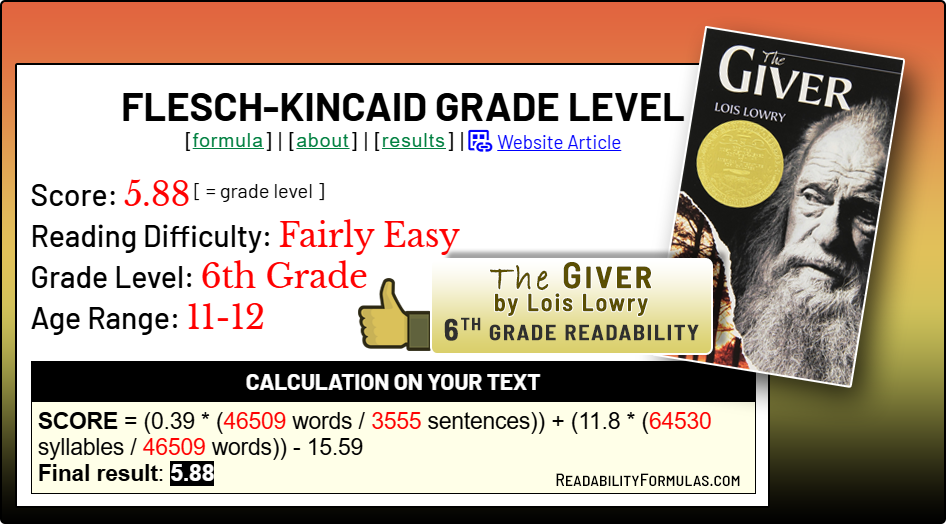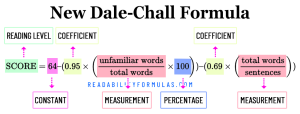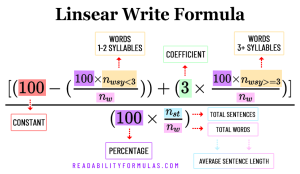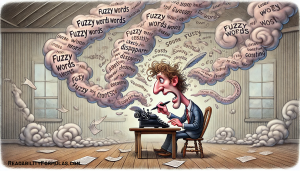 The Flesch-Kincaid Grade Level improves upon the Flesch Reading Ease formula. Rudolph Flesch, an author, writing consultant, and the supporter of Plain English Movement, developed this formula with John P. Kincaid. The term readability, as it relates to text, is “the ease with which a reader can understand and comprehend the content.” A text with high readability is accessible to a broader audience—it’s clear, concise, and understandable.
The Flesch-Kincaid Grade Level improves upon the Flesch Reading Ease formula. Rudolph Flesch, an author, writing consultant, and the supporter of Plain English Movement, developed this formula with John P. Kincaid. The term readability, as it relates to text, is “the ease with which a reader can understand and comprehend the content.” A text with high readability is accessible to a broader audience—it’s clear, concise, and understandable.
This formula scores readability by analyzing the following:
1. Sentence complexity: Longer and more intricate sentences usually increase the difficulty of text. Conversely, shorter and basic sentences add to a lower grade level score.
2. Choice of Words: Difficult and unfamiliar words raise the reading difficulty, while simple and common words have the opposite effect.
3. Textual Cohesion: A well-organized and logically-connected text improves comprehension, resulting in a lower grade level score. In contrast, a disorganized and incoherent text raises the grade level.
By analyzing sentence length, word difficulty, and text cohesion, the formula measures how challenging readers may find a text.
The formula is as follows:
$$0.39 \times ASL + 11.8 \times \frac{n_{sy}}{n_{w}} –
15.59$$
The Flesch-Kincaid Grade Level
ASL = Average Sentence Length (i.e., the number of words divided by the number of sentences)
ASW = Average number of Syllables per Word (i.e., the number of syllables divided by the number of words)
Nw = number of words | Nsy = number of syllables
The score indicates the grade-school level; i.e., a score of 5.3 means that a fifth grader can read the text without difficulty. This grade-level score ensures teachers, parents, librarians, and others don’t match books and texts that students would find too challenging.
The Giver, an award-winning novel by Lois Lowry, is a staple in many middle school and early high school curricula. Flesch-Kincaid scored the book at a 6th grade-level, which is the reading level validated by teachers and librarians.
Rudolf Flesch and J. Peter Kincaid tested their formula through a systematic and data-driven approach.
- Data Collection: Flesch and Kincaid collected materials from a wide range of sources and genres, including textbooks, articles, literature, and legal documents. These texts represented different levels of complexity.
- Development: Drawing from their expertise in language and linguistics, Flesch and Kincaid identified key factors that influenced text readability. They focused on elements such as sentence length, word difficulty, and textual cohesion. This helped them produce a quantitative measure.
- Formula Testing: To test the accuracy of their formula, Flesch and Kincaid applied it to the collected texts and calculated readability scores for each one. These scores represented the grade level needed for comprehension. They compared the formula’s results with subjective assessments from students.
- Validation: Flesch and Kincaid validated their formula’s effectiveness by adjusting and refining the results to improve its accuracy and align it with human perceptions of readability.
- Application: Flesch and Kincaid demonstrated its practical applications in the academic field. Educators used the formula to score educational materials that they then matched to students’ reading skills. Academic publishers used the formula to create age-appropriate content for different grade-levels.
- Ongoing Research: Flesch and Kincaid continued to expand and refine the formula’s application and performance over time.
While the formula is useful to score text readability, it is limited by the following:
- Writing Styles: The formula may not accurately score texts that use language in uncommon ways, or texts written in different regional styles of speaking, also known as dialects.
- Prior Topic Knowledge: The formula does not consider readers’ prior knowledge of the subject matter. Readers may perceive texts differently based on their familiarity with the subject.
- Non-Quantitative Metrics: Relying on quantitative metrics might not capture all aspects of text complexity. Nuances like writing style, tone, and rhetorical devices can influence readability.
Despite these shortcomings, the formula is widely used in these industries:
1. Educational Publishing Industry
According to the National Center for Education Statistics , about 32 million students in the United States struggle with reading, which underscores how important it is to provide age-appropriate and accessible educational materials. Example: an 8th-grade science textbook contains lengthy sentences and technical terms, making it difficult for students to fully understand. The textbook is revised to include shorter sentences and more familiar words. Students can now comprehend the concepts more fully and perform better academically.
2. Legal and Policy Documents
In a survey conducted by the American Bar Association , 78% of respondents stated that legal documents are often too difficult to understand, leading to confusion and potential legal issues. Research indicates that simplifying legal language can lead to better compliance and understanding. Example: a legal contract uses complex jargon and convoluted sentences, creating confusion. The contract is simplified with clear language and straightforward sentences.
3. Digital Marketing and Online Content
Nielsen Norman Group , a user experience research firm, found that 79% of users scan online content rather than reading it thoroughly. Using readability formulas to create concise and reader-friendly content can improve user engagement and retention. Example: a blog post on a health website uses medical terms and lengthy explanations, alienating readers seeking simple health advice. The blog post is edited to use plain language and shorter sentences, making it more reader-friendly and appealing to a broader audience. HubSpot , a marketing software company, reported that blog posts with a Flesch-Kincaid Grade Level between 6 and 7 have higher readability scores and receive more social media shares and backlinks.
4. Research Papers and Academic Writing
The American Psychological Association (APA) encourages clear and concise writing so research papers are more accessible. Example: a scientific research paper uses complex terminology and academic language, limiting non-experts or individuals from other fields to understand the information. The research paper is revised with simple language and shorter sentences, encouraging a wider audience—including the general public—to access the information.
5. Government and Public Policy
According to a study by the Center for Plain Language , 53% of Americans struggle to understand government and legal documents. Using readability formulas can improve citizens’ understanding and foster better decision-making. Example: a government document explaining public policies uses bureaucratic language and long paragraphs, hindering citizens’ comprehension of the changes. The document is revised with clear, concise language. Citizens can now understand and act on the policies.
You can use our Readability Scoring System to score your text using the Flesch-Kincaid Grade Level and Flesch Reading Ease.
Scott, Brian. “Learn How to Use the Flesch-Kincaid Grade Level Formula.” ReadabilityFormulas.com, 18 Nov. 2024, https://readabilityformulas.com/learn-how-to-use-the-flesch-kincaid-grade-level/.









